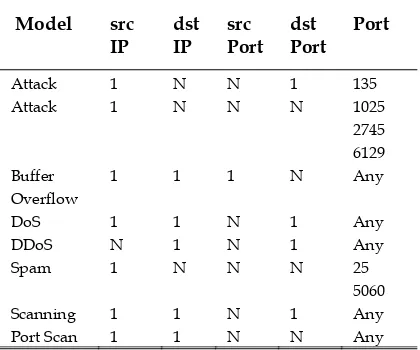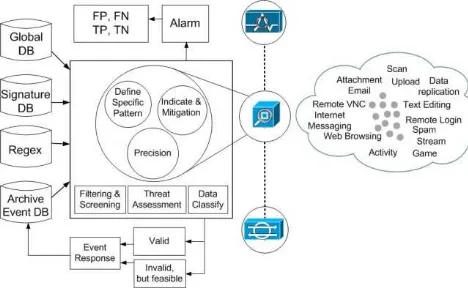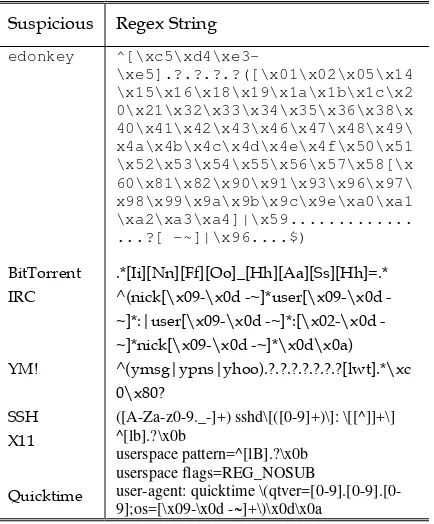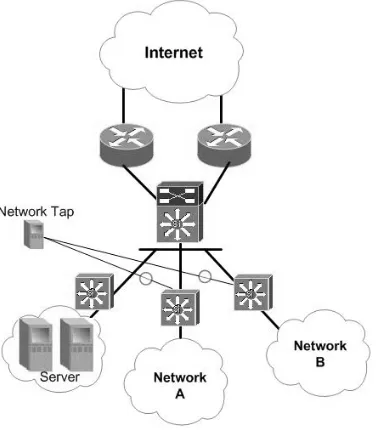WWW.JOURNALOFCOMPUTING.ORG 1
Classification of Habitual Activities in
Behavior-based Network Detection
Deris Stiawan, Abdul Hanan Abdullah, and Mohd. Yazid Idris
Abstract— this paper presents a new method to detect network traffic threats based on packet classification which is result from the identification of insider’s habitual activities. We assess the habitual activities by examining regular expression of web applications use by insiders together with the existing server activities log and rules pattern from global update. We capture the packets, analyze the packet and finally, categorize into three main categories whether it is normal, suspicious or malicious. Our method is able to detect threat with low false alarm rate and provides event list handler to rate the risk for prevention purposes. We apply our method to evaluate system security for help security officer (IT Manager and Administrator) to be aware of status network activities.
Index Terms— Intrusion prevention, Accuracy, Precision Alarm, Behavior-based, Habitual Activity
—————————— ——————————
1 I
NTRODUCTIONccording to CSI/FBI (www.gocsi.com), over 44 per-cent of all computer crime and insider abuse comes from internal system. The study asks respondents to rate “internal systems” in 2008. Furthermore, defense sys-tems can identify and recognize intruder attack that is breaking into system. There are several factor, such as : (i) many tools/script to hacking attack from Internet, (ii) behavior user (skill / ability), and (iii) weakness in the internal system. Meanwhile, reports from CERT (cert.org/stats/cert_stats.html), show that the number of incident reported total of catalogue vulnerabilities has increased from only 5.990, to 6.058 Quarterly in 2008.
In general, insider users have privilege as authentica-tion and authorizaauthentica-tion access to resources. In this case, distinguish between insider threat and outsides /external attack is an insider has greater privilege and knowledge of their organization and can face greater penetration to resources than external attackers (e.g. topology, devices location, mapping network, security control, privilege mechanism and application of assets or targets). There-fore, steps and stages insider attack to penetration attack resource can be possibly easy than penetration from out-side attacker. Additionally, In this case reports from CERT (cert.org/insider_threat) corroborate this fact, which is the number of incident reported has evolved from 2004 until in 2010.
The paper is organized as follow. Interaction behavior user with environement resources is describes in Section
2. Section 3 presents the detail threat assessment mechan-ism. Section 4 we proposed accuracy and risk rating me-chanism to identify and recognized threat. Conclusion and future work are shown in Section 5.
2 I
NTERACTIONB
EHAVIORU
SERAccording to [1], proposed the categorized behavior
user, such as (i) user characteristics, (ii) user attitude (iii)
user knowledge & capabilities, and (iv) user time space.
They and explained between technology and behavior
and examined the relationship man‐made environment
and psychological process. As in Figure 1, we present a
component of the model and their interaction given net‐
work technology and user. In mark A : there are (i) net‐
work resources, such as Database, query, dataset, etc, and
(ii) environment technology, such as router, switched,
firewall, authentication systems, etc, in this section net‐
work resources and environment technology is concerned
about update, standard interface, proprietary, system
connections, and reliability.
While in mark B, mapping show that there are several conduct from user, such as attitude (naïve or loutish), habitual activity, perceived control, subjective norms in-tention, occasion timing, planning, and ability. Two user categories are divided inside and outside, that have simi-larities in mark B. Layer applications / human computer interface (HCI) is a middleware to become translated and query interaction / processing between A and B. There-fore, we see that the implication of this interaction is ethi-cal.
This idea from proposal [5], their was analyzed of user activity is a natural approach to detect intrusion, expe-rience has showed that it is far from being accurate. It is possible to identify several causes for this change.
————————————————
• Deris Stiawan is Ph.D Candidate in Faculty of Computer Science & Infor-mation System, Universiti Teknologi Malaysia.
• Abdul Hanan Abdullah is a Professor at Faculty of Computer Science & Information System, Universiti Teknologi Malaysia
• Mohd. Yazid Idris.Ph.D is a team leader Intrusion and Threat Detection (ITD) group at Faculty of Computer Science and Information System, Un-iversiti Teknologi Malaysia.
A
© 2010 Journal of Computing Press, NY, USA, ISSN 2151-9617
WWW.JOURNALOFCOMPUTING.ORG 2 Propsosal [3], present malicious motivation, that it comes
from personal gain, revenge, ideology or all of the above. They reported 80% insider threats are committed by the most technical and privilege users, with 50% of that event being committed accidentally.
Figure 1. Interaction user with environment resource
According to [4], the concluded survey was evidenced as seen above, there are many naïve user behaviors that are not intended but many cause detrimental effects on information security, which use social cognitive theory and explore its viability as a framework for understand-ing factors influencunderstand-ing end users control-enhancunderstand-ing beha-vior.
We assume the skill / ability users have almost the same average. As we shall discuss in this section, the cor-relation security system highly dependent on behavior habitual activity.
3 T
RAFFICT
HREATA
SSESMENTBased on these opinion experimental results, we iden-tify habitual activity liked black, white and gray, (i) nor-mal activity: a system consists in observing it while it is working under normal conditions, which is used to measure normality, related to this behavior at one or sev-eral time activity, (ii) suspicious activity: conditions of uncertainty between known activity and malicious, (iii) malicious activity : justification detection from anomalies and suspicious attacks, mechanism and method of attack. Thus, the effect is inaccuracy for recognizing and not be-ing able to detect it, and (iv) unknown activity: intersec-tion between normal and suspicious and suspicious and malicious, that implies several consequences and is in-convenience to detecte before update rule in list database.
The ideal approach is to identify and recognized its
from variants behavior. An habitual activity can be de-fined as a properties of network, such as (i) Payload (IP Address, MAC Address, flags, protocol, port, packet size / length, header, fragment, TTL, frame, checksum, type, etc), (ii) characteristics of attack, (iii) match with signature rules of databases global, and (iv) pattern of normal be-havior.
3.1 Known Activity
Unfortunately, it is very complex to identify and rec-ognized normal activity, suspicious or malicious, we pro-posed a mechanism to recognize when any traffic is al-lowed to pass from other defense system to any host out-side or resource in our network. Below as part of TCP/UDP [5], we have as follows:
1. Packets with low TTL values
2. Packets with the same source and destination port
3. Packets containing private IP address and/or other
address violations
4. Packets with invalid TCP flags
5. Packet containing zero port number
6. Packet with strict source routing option
7. Too short packet
Characteristics of malicious threat with srcIP = source IP, dstIP = destination IP, srcPort = source port, dstPort = destination port, and proto = protocol, as follows in Table 1. Characteristics malicious event [6], as follows:
1. Network, system, services and information recon-naissance (profiling)
2. Access to assets (profiling)
3. Illicit Data extraction (e.g. printing, write to re-movable disk)
4. Installation and control of data loggers or mali-cious software Communication Usage (e.g. P2P, VoIP, encrypted messaging, steganography) 5. Changing file permission
6. Altering file content 7. Erasing file/data
Table 1. Characteristic of malicious threat
Model src IP
dst IP
src Port
dst Port
Port
Attack 1 N N 1 135
Attack 1 N N N 1025
2745 6129 Buffer
Overflow
1 1 1 N Any
DoS 1 1 N 1 Any
DDoS N 1 N 1 Any
Spam 1 N N N 25
5060
Scanning 1 1 N 1 Any
WWW.JOURNALOFCOMPUTING.ORG 3 Table 2. Characteristics of normal
Model src
From our observation, we can describe profiles user with convention continuously activity access, it is called habitual activity. Proposal [10] present social cognitive theory postulates the reciprocal nature of interaction among behavioral, personal and environmental factors, they use analysis survey with questioner about security aspect in organization. Therefore, we can summarize that the behavior is an effective way to identify and detect threat from habitual activity. Additionally, as a basis, we have a special characteristic unique that can be used for habitual activity motivation to provide the obvious ex-tended user motivation.
Furthermore, from proposal [11],[12], we can include behavior user for mapping habitual activity to our ap-proach, especially interaction behavior and attitude user with the new emergence web 2.0 applications. In addi-tion, as a basis, we hold from them to identify the new emergence application have a special characteristic can be used for habitual activity motivation to provides the ob-viously extended user motivation.
We divide to distinguish normal or curious activity with classes/types number of connection. Connection one to one (i.e. Remote login ), one to many (i.e. Bit Torrent / Slammer), many to one (i.e. DoS/ DDoS), and many to many (i.e. Ragnarok). Furthermore, from our observa-tions, there are two habitual behavior activities: (i) media rich with activity higher transaction size, and (ii) transac-tion with activity concurrent connectransac-tion, as follows in Table 3 and Table 4.
As in Figure 2, we describe and classify interconnec-tion habitual activity with number of connecinterconnec-tion of activi-ty user in Table 5.
Table 3. Level of higher transaction size, between more transactions per connection
Activity Applications
WWW Browsers, http
Collaborative Workspaces
Google Apps, Google Readers, blogs
Download - Upload
P2P, FTP, updates process : System Operation, Anti Virus, Applications Streaming video You Tube, Real time, Quick time,
YM Webcam.
Data Replication Backup data, mirroring data in other sites.
Remote Login SSH access, WinSCP, Putty
Remote VNC (Remote desktop), to other remote
PCs in network.
Mail SMTP, POP, IMAP
Table 4. Level of concurrent connection, between higher connection rates
Activity Applications
E-Commerce https
Internet Mes-saging
YM!, mIRC, ICQ, Pidgin, Adium, GTalk, Skype.
VoIP Skype, YM Voice.
Game online Ragnarok, HalfLife, Age of Empires, Ayo Dances.
Scanning Scanning port using script tools
Table 5. Number of connection of activity user
Connection Activity User
WWW.JOURNALOFCOMPUTING.ORG 4
Figure 2. Simple of Classifying
4 A
CCURACY&
R
ISKR
ATING 4.1 AccuracyWe believe that the overall performance of this hybrid architecture is better to appropriately identify and recog-nized threat in network traffic. In our design, we divided three modules which has task. We use modules, (i) filter-ing and screenfilter-ing, (ii) threat assessment, and (iii) data classify. Furthermore, the module uses two ways to posite, (i) OR-based composite, one (ii) AND-based com-posite. On security violations we matched, an alarm raised to trigger event response.
Figure 3. Combining event and list database
As in Fig. 3, we depict our approach to increasingly accuracy and precision intrusion threat. We use data min-ing approach, as the intrusion detection method. This algorithm is capable of solving the match network traffic with database. We utilize data mining technique to con-struct a filter identify packet data to decrease false alarm. Packet traffic inbound-outbound from router devices in layer network, our approach do not handle of the routing configuration.
In our approach sensor module in interface outbound and inbound by considering each category behavior activ-ity. This is an approach combination with other criteria
from collecting in database (regex, achieve, archive event, and signature). Therefore, for one module to connecte database machine, we use spread database to store the events, such as: (i) global database, from update rules identifications global database, (ii) signature database, we uses snort rules, the signature have to be update in the database for future verification process, (iii) regex: regular expression that can be used in selectors to define ranges of values instead of defining each possible value separate-ly, and (iv) archive database: event database, logging sys-tem, operating system event, application logs, file system information and reporting log.
(i) Global database
drop tcp $HOME_NET any -> $EXTERNAL_NET $HTTP_PORTS (msg:"D BACKDOOR trojan agent.aarm runtime detection - download other malware"; flow:to_server,established; uri-content:"/retadpu.php?"; nocase; uricontent:"version="; nocase; uricontent:"configversion="; nocase; tent:"GUID="; nocase; uricontent:"cmd="; nocase; uritent:"p="; nocase; content:"Host|3A|"; nocase; con-tent:"wr.mcboo.com"; distance:0; nocase;
pcre:"/^Host\x3a[^\r\n]*wr\x2emcboo\x2ecom/smi"; class-type:trojan-activity; sid:14083;)
alert tcp $HOME_NET any -> $EXTERNAL_NET $HTTP_PORTS (msg:"A POLICY XBOX avatar retrieval request"; flow:to_server,established; uricontent:"/avatar/"; tent:"User-Agent|3A| Xbox Live Client/";
con-tent:"Host|3A|avatar.xboxlive.com|0D 0A|"; class-type:policy-violation; sid:15172;)
logging tcp $EXTERNAL_NET any -> $HOME_NET 5003 (msg:"D EXPLOIT Symantec Discovery buffer overflow";
flow:established, to_server; content:"|ED ED|"; depth:2; offset:2; content:!"|ED|"; depth:1; isdataat:1176; con-tent:!"|00|"; depth:976; offset:200; classtype:attempted-admin; sid:11670;)
(ii) Signature database
BACKDOOR Pushdo client communication attempt - ID 15165 Flow to_server,established,infected files
:%System%\rs32net.exe | xcommsvr.exe |vsserv.exe|vsmon.exe|symlcsvc.exe sspfwtry2.exe|safensec.exe
1000 IP options-Bad Option List 1200 IP Fragment buffer full 2000 ICMP Echo Reply
3005 TCP FIN Port Sweep 11010 Swapper File Request 11200 Yahoo Messenger Activity 11251 Skype Client Activity
19500 Oracle Stack-based buffer overflow vulnerability 20759 TheWebForumLogin.php Username Param SQL Injection
(iii) Regular Expression database
WWW.JOURNALOFCOMPUTING.ORG 5
Tabel 6. Sample data regex
Suspicious Regex String
edonkey
^[\xc5\xd4\xe3-BitTorrent .*[Ii][Nn][Ff][Oo]_[Hh][Aa][Ss][Hh]=.*
IRC ^(nick[\x09\x0d ~]*user[\x09\x0d
~]*:|user[\x09\x0d ~]*:[\x02\x0d
-Quicktime user-agent: quicktime
\(qtver=[0-9].[0-9].[0-9];os=[\x09-\x0d -~]+\)\x0d\x0a
(iv) Archieve database
In fact, on archive event database, while sensor refers trigger alarm, attempt, penetration, and misuse. An at-tacker will capture and labeling to specify stored in arc-hive event. For example event databases as following.
2006:04:19-00:20:50 host ulogd[1848]: UDP_FLOOD: IN=br0 OUT= MAC=00:07:0e:9c:6d:62:00:04:9a:ef:d3:a0:08:00 SRC=204.16.208.11
2 DST=202.93.35.204 LEN=449 TOS=00 PREC=0x00 TTL=57 ID=0 DF PROTO=UDP SPT=38689 DPT=1027 LEN=429
# Oct 17 15:34:04 202.146.176.45 222.73.238.152 33945 33903 17 0x0 29 70 0x4000 0x0
From our experiment, we have test several global da-tabase to improve and associate with our approach, such as blacklist categorized for defense system (http://cri.univ-tlse1.fr/blacklists/index_en.php).
Depicted, as in Fig. 3, the implementation of our ap-proach consists of three main modules. Here, this system is updated regularly, the system will initially check the payload and Regex, and it checked with database for its existence, if it exists, the system will take an appropriate action to trigger alarm. We assumed, each database will contain more than 500,000 event list. Furthermore, the event still frequent automatic updates.
The fundamental accuracy for identify threat is low (FP) and (FN) between high (TP) and (TN) rates. We ob-serve that the accuracy affects the correctness of deciding whether an attack exists in real-traffic, notifying the log-ging system of an attack based on the list in the database. To summarize the four possible cases, Accordingly, TN as well as TP is to identify operation detector, which is la-beled as normal or known activity. On the contrary, FP and FN are the events that undermine the detection per-formance when unknown or suspicious is not identify. From our review, these high-level alarms can be used as the base to perform further higher-level threat analysis. By using our approach, every unknown activity or suspi-cious threat has labeling.
4.2 Risk Rating
Risk rating (RR) can describe a threat rating based on numerous factors besides just the attack severity. The RR is calculated according to not just the severity of the at-tack but also (i) event response, (ii) signature fidelity, and (iii) asset value of target. Wherefore, the RR detects an attack the rule set get rate mark to reduce FP Alarm.
The target value RR enables to configure an asset rat-ing from specific habitual activity. Therefore, from our observations, there are two habitual behavior activities, which the asset RR can be one of the values: (i) media rich with activity higher transaction size, and (ii) transactional with activity concurrent connection. For the present RR calculating, we uses the concept of likehood, it can be useful when prioritazing risk and evaluating the effec-tiveness of potensial threat.
The likehood estimation is subjective to combination and is typically expressed as a RR of high, medium and low. Additionally, in previous work [7] and [8], they de-scribe relations accuracy with RR to increasingly recog-nized threat. As mentioned above, we shown one poten-tial model for calculating likehood as in Table 7, from Table 4 and Table 5, we show simple example of calculat-ing risk by relative likehood that the habitual activity from inside user can occur and the value of the expected incurred loss.
WWW.JOURNALOFCOMPUTING.ORG 6
Table 7. Simple Risk Calculation of Habitual Activity
Activity TL LE Risk
WWW 3 2 High
Collaborative Workspaces
2 2 Medium
Download - Upload 3 3 High Streaming video 2 3 High Data Replication 1 3 Medium Remote Login 2 1 Low
Remote VNC 1 3 Medium
Mail 3 1 Medium
E-Commerce 2 1 Low
Internet Messaging 3 1 Medium
VoIP 2 2 Medium
Game online 3 3 High
Scanning 2 1 Medium
5 E
XPERIMENTAL&
R
ESULTSIn this section, we represent dataset to collecting data from popular dataset intrusion domain and the overall system existing topology as shown in Figure 4.
Figure. 4. Topology network experiment
We have core network to connected distribution and access layer network. To running and composite two ISP, we use load balancing based for optimized the band-width. We located and provided one server running Fe-dora to tapping traffic. Furthermore, wireshark were set up on the machine to captured traffic from interface net-work A. The netnet-work used for this observed with over 200 user. We show in Table 8, the packet processing from network tapping in 6 days with reach out average packet /second 97.963 from 2.300.547 totally packet.
Table 8. Packet Processing
Day Packet Avg/ sec
UDP TCP None
Day 1 272.009 20.573 44.94% 54.51% 0.55%
Day 2 477.583 15.698 59.84% 39.31% 0.8%
Day 3 317.115 13.850 89.51% 8.93% 1.56%
Day 4 406.448 15.292 88.61% 10.09% 1.30%
Day 5 416.850 14.458 84.82% 14.06% 1.12%
Day 6 410.542 18.092 47.79% 51.42% 0.79%
As it can be observed in Table 9, we show taxonomy steps of attack with commonly used script applications:
1. Probe, the attack looks for a vulnerability of system, the attacker usually execute ping command, interro-gation of DNS or domain
2. Scan, the attack uses tools to find a vulnerability holes to compromise the host, scanning is try to find information vulnerable a system, it is can produce in-formation, such as IP Address devices, scheme of to-pology, and application systems of running
3. Intrusion, the attack installs something on system, uses the compromised host to attack other systems, the attacker try and error to penetration,
4. Goals, damage occurs, either through malicious in-tent or huge amount of network traffic because of propagations, after that, attacker installed backdoor to be easy re-enter the system.
Table 9. Identify & Recognized Suspicious Threat
Steps Script Detection
Probe Http Spyware 95.55%
ICMP Ping 95.67%
Scan Nmap 100%
Nessus 100%
Traceroute 100%
Intrusion ARP Poison 99.99%
Brute force attack 99.99%
DoS 99.99%
Worm trojan 75.50%
Input injection 86.79%
Spammer 90%
Keylogger 99.99%
Goal Rootkit 100%
Backdoor 100%
6 C
ONCLUSION&
F
UTUREW
ORKpa-WWW.JOURNALOFCOMPUTING.ORG 7 per, we apply our new model distinguish
nor-mal/unknown habitual activity with observe regular access user and involved risk rating calculation. In the future, we plan to apply this method with Behavior-based attack algorithm in a real-traffic network.
REFERENCES
[1] P.P Verbeek, et all “User Behavior and Technology Development : Shaping Sustinable Relations Between Consumers and Technology, pp. 385‐399, Springer, 2006.
[2] K.V Kumar., “Securing Communication using function extraxtion technology for malicious code behavior analysis”, Computer & Security 28 (2009), pp. 77‐84, Elsevier, 2009.
[3] T. Walker, et al, “Practical management of malicious insider treat – An enterprise CSIRT perspective”, Information Security Technical Report I3 (2008), pp. 225‐ 234, 2008
[4] H.S. Rhee, et al “Self‐efficacy in information security :it influence on end users information security practice behavior”, Journal Computer & Security 28, 2009.
[5] J.M.E. Tapiador, et al, “ Anomaly detection method is wired networks: a survey and taxonomy, Computer Communication 27 (2004), pp.1569‐1584, Elsivier, 2004
[6] G. Doss, et al,” Developing Insider Attack Detection Model : A Grounded Approach, ISI 2009, 2009
[7] A. D. Todd, et al, “Alert Verification Evaluation Through Server Response Forging” LNCS, vol. 4637, pp. 256‐275, Springer, 2007
[8] T. Abbes, et al, “A Traffic Classification Algorithm for Intrusion Detection”, IEEE 21st International Conference
on Advanced Information Networking and Application Workshops (AINAW’07), 2007
[9] M. Mark, et al, “Analysis and detection of malicious insiders, In 2005 International Conference on Intelligence Analysis, 2005
[10] Hyeun‐Suk Rhee, et al “Self‐efficacy in information security : it influence on end users information security practice behavior”, Journal Computer & Security 28, 2009
[11] W. Kim, et al, “On social Web sites”, Journal of Information Systems, Volume 35, Issue 2, pp. 215‐236, Elsevier, 2010.
[12] C.Y.Wang, et al, “Emotion and Motivation : Undestanding User Behavior of Web 2.0 Application”, International Conference on Information Technology : New Generations, 2009
Deris Stiawan. Holds an M.Eng from University of Gadjah Mada, Indonesia, since 2006, he is Computer Science faculty member at University of Sriwijaya, Indonesia. He is IEEE member and current‐ ly pursuing his Ph.D degree at Faculty of Computer Science & In‐ formation System, Universiti Teknologi Malaysia working in intru‐ sion prevention system. He joined research group Information As‐ surance and Security Research Group (IASRG) at Universiti Tekno‐ logi Malaysia. His professional profile has derived to the field of computer network and network security, specially focused on intru‐ sion prevention and network infrastructure.
Abdul Hanan Abdullah.Ph.D, Receive the B.Sc. and M.Sc from San Francisco, California, and Ph.D degree from Aston University, Bir‐ mingham, UK, in 1995. He is a Professor at Faculty of Computer Science & Information System, Universiti Teknologi Malaysia. His reseach interest is in Information Security. He is also a head of Per‐ vasive Computing Research Group (PCRG) UTM and member of ACM.




